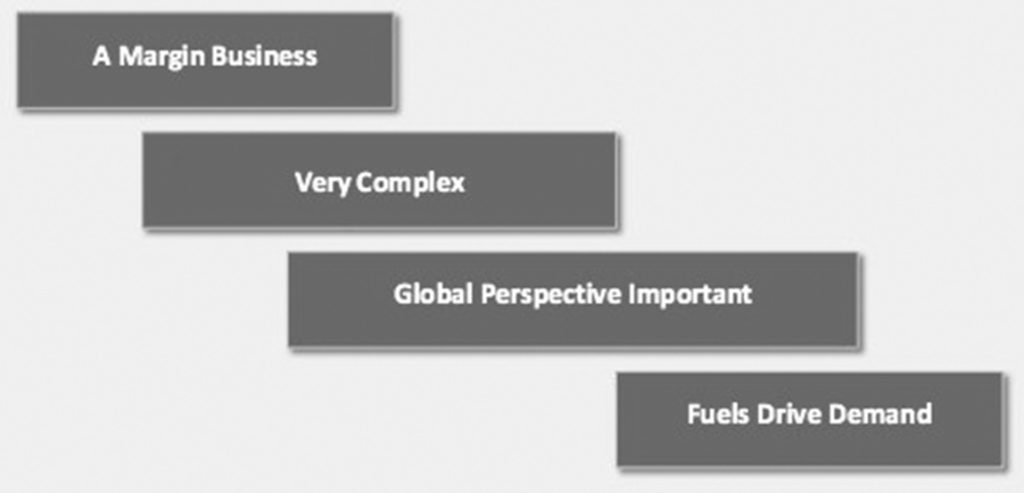Downstream is the processing and selling of refined products in the oil and gas business. These products just do not include gasoline and diesel, but a whole gamut of products as outlined below.
The “super majors” like ExxonMobil are involved in many elements of these processes as joint venture partners in hundreds of money-spinning projects. This is where the real money in the industry resides and this is the true value-added portion of the value chain. Guyana is not in control of any part of this value chain in this Exxon deal; this is all Exxon.
So while we are debating over the peanuts of whether Guyana will earn US0,000 or US0,000 per day in the upstream sector, Exxon will be making multiples of that in the downstream sector. This deal was stacked against the ordinary man from day one and thus the entire project should have been more competently leveraged to the point where Guyana should have sought minority shareholding for the local content element for the entire value stream (downstream, midstream and upstream). This was done before for other countries, so why can’t it be done for Guyana?
Singapore is described as the “undisputed oil hubs of Asia” but guess what? They have no crude oil! Yet they collectively employ some 40,000 people and generate some US billion worth of petroleum business for their country because they have an “attitude of mind” to make their country relevant in the business world.
Key downstream business sectors include:
* Advance oil refining
* Petrochemical manufacturing
* Wholesale and retailing to end-users
Drilling down, many of the downstream products are not conventionally associated with crude oil such as body products, pesticide, synthetic fibres such as nylon, synthetic rubber, pharmaceuticals, plastics, fertilisers and hundreds of other products. But without crude oil, they would not exist.
The diagram below gives you a broad outline of the characteristics of the downstream sector.
> It is a Margin Business – Margin in the downstream business is the difference between the selling price of the value-added products and the purchase price the refinery pays for the crude. Although the price of crude sets the absolute level of the different product prices it is not the only driver in setting the margins on what the market will pay for products in the downstream side of the business. Downstream margins tend to be squeezed when crude price increases but the more high end the process, the less reliant is the sale price on the crude oil price.
> It is a Very Complexed Business – the downstream segment requires much high-level science to be successful. Although Singapore does not produce one drop of crude oil, it used its advance education system and easy access to capital to play a major part in the higher value end of this “hydrocarbon value chain”. Singapore exports some US$40 billion of refined oil-related products by buying crude oil cheaply and using their local talent and capital to turn that raw product into refined products that the world demands.
> Global Perspective – The energy supply chain is global and those who are sellers into that chain have a greater advantage in the global market than those who are buying from the supply chain. That is why oil-producing countries that manage a greater portion of the oil business value chain are expected to leverage great value for their shareholders. Guyana must demand a greater say in this value chain and should not just be an idle bystander to the process.
> The final piece of this column today is an understanding of the drivers of the end-user consumption patterns. At the end of the day, the end users are the people who provide the ultimate value for oil and gas products. Globally, the most widely known crude oil product is gasoline. The countries that export crude oil do not control the real dollars but those that exports the refined products like gasoline have a much larger command of the real dollars. In 2016, the United States imported 10 million bpd of crude oil and exported five million bpd of refined petroleum products. This statistics tell you clearly why the USA, Holland, Russia, Singapore and India will remain dominant in this business for a long time – they dominate the right end of the business, the refined products.
That is why it is so critically important that an oil refinery be built. From every barrel of crude produced, there is US$6 of pure profit for each barrel refined and I am only referring to the process to gasoline, diesel, jet fuel and heavy oil products such as bitumen. Can you imagine if that process can be further advanced to fertiliser, pesticides, plastics and so on? We are talking about tens of millions of US dollars per day.
By Sase Singh
Oct 6th, 2017






